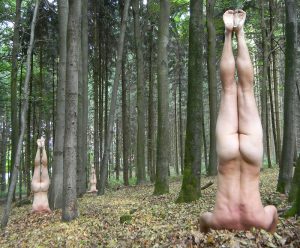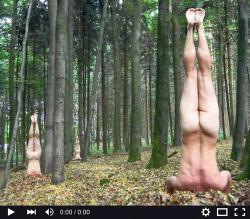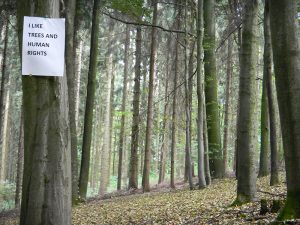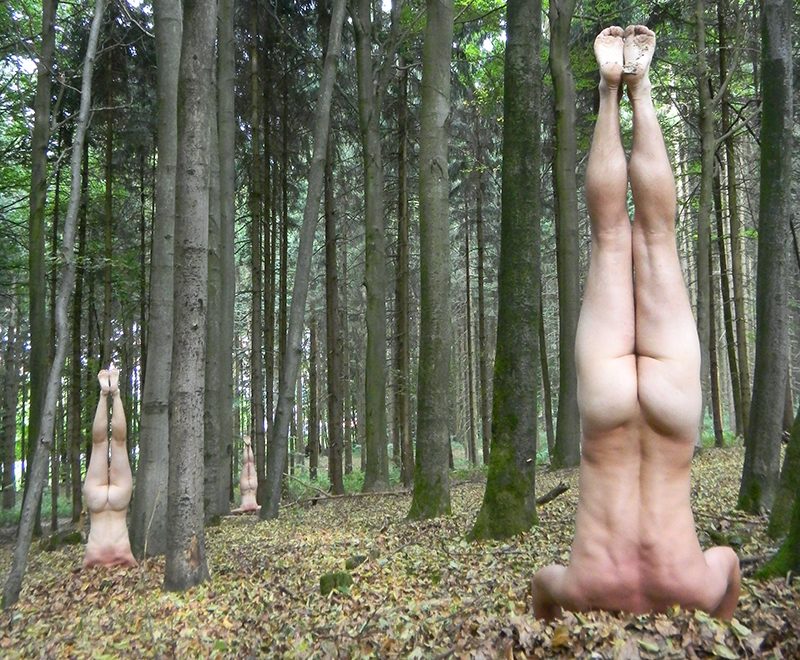The Biomechanical Ballett, or: I Like Trees And Human Rights
Quasikunst-Project: The Biomechanical Ballett, Performance in the Woods, Pictures and Text, 2015

The Group Quasikunst has planted out culture and nature. And themselves all alike. An interview with Quasikunst – about inverted human beings, green hells, biomechanics and detoxing.
Referring to the first picture: People put into the ground, inverted with their heads, in the midst of a forest. What is it about?
There are many approaches. One of our favorite references is, at the moment, a recourse to a notion of Democritus. According to it, trees are like people planted with their heads in the ground – they can do everything people can do as well, with the exception of the things people could not do in the respective position. At first, this sounds amusing. All at once, new, enormous and omnipresent populations emerge. Whole green hells of intelligent beings, which grow in front of you. And you as an inverted scion suddenly are a part of it. However, and that is already the first finding of the experiment: You actually can do little of the common things, in an active human sense, when you are stuck with your head in the ground…
For instance movement and locomotion gets lost.
Indeed. Visual sense in its common functionality gets lost, and the other senses become narrow and limited. Nothing works anymore. Everything is different, an inverted world, with a lot of soil in one´s vision. Blood shoots into the head. You find yourself mute and trapped, with your feet in the air, without the possibility of movement. One begins to think: The bodily functions need to be reorganized. An interesting thought experiment, to ask oneself, in that position, whether there could be something to that ancient notion. The tree as a man, stuck in the soil, inverted.
What makes such a scenario attractive?
Several things actually, for instance: In our tradition of knowledge there has always been the notion that plants, in the hierarchy of things and living beings, have nothing to do with intelligence. Yet it seems to become ever more obvious that plants do not only possess the same senses as humans do, just organized in a different way – eventually plants have even more senses than humans, a sense for gravity, for instance. With their roots, that work like biomechanical computers, they share information in their immediate surroundings as well as over large distances, solitary, in groups, etc. In a certain respect, their heads actually are in the ground… But we also like the hew hybridity of man and tree, which forms a new population in the forest, maybe a new population in general. That game of deception. In addition to this there comes the inversion of man in itself, the inverted. This attitude also constructs something different in man. Think of a reference to real ballet where the head is defined as the highest of spheres. The human mind was taken to the extreme. The romantic gesture but obfuscated that below the head, erected into the firmament, pure geometry was displayed, with limbs that took their position with machine-like precision. That mechanical fixation towards the mental and intellectual had been critically addressed already at the turn of the last century, and among other things more prominence was given to the body. The affirmation of bodily work, which sets “inner”, mental processes into motion in the first place, is, within the system of art, without doubt a reference to Wsewolod Meyerhold and his Biomechanics, which can be dated in the year of 1920. Yet in a certain way this project, the Biomechanical Tree Ballet, introduces yet another kind of realism, as the body gets completely inverted and the head descends, goes to the ground. The torso and the extremities form a residual system.

The button implicates that a film starts.
It is an image with a button. Yet the button is not any more retrievable, as if I would place a link in a book, leading to nowhere. As if, for the purpose of communication with nature, I put my head in the ground. Something starts and something is actually there as well as it is imaginary. It is, in this respect, also the fictitious biomechanical ballet. One could all of this take to the end and realize it – but for what reason? We do not want to start such a thing at all. That is just bound to dissolve into the usual strategies of commodification, no matter of the respective system it is embedded. There is no real tree ballet. In contrast, we make reference to Democritus, a natural philosopher and, according to legend, a buoyant spirit. And we refer to Meyerhold, a Russian revolutionary director, who used his biomechanics against a sclerotic naturalism. We invite to the dance, without commitment. We want to address contradictions in a different way. Possibly come up with a different dialectics, as firmly established opposites and dichotomies, that leads to nowhere particular in the first place. Insofar, it relativizes any “mystery” into a “misery” as it reveals pure meaning apart from any functionality. With this “chain of meaning” the head that thinks was buried and made invisible beneath the surface. Instead, the head wants to get linked to a different information system, that of the plants. Everything exists as an idea only. The will to it establishes a different, distinguished setting. Anything else should not happen in order to prevent it from drifting into regular categories too soon, not least in the definition of art and its regular means to attract attention, from fine arts to the spectacle. What you have here are fragments from a more comprehensive context of realization and execution. Also because of this it is quasi-art/Quasikunst which accelerates to a frontier of attention and execution but which is really there as a statement and as an accumulation of meaning and context. It is also an articulation of needs in the underground.
What kind of group Quasikunst is exactly supposed to be?
Most definitely it is a collective of a different kind. Consequentially, one could attribute this collective not only as a group but also as a quasi-group. Because it extends into an open structure, consisting of humans dead and alive, as well as of things and context, of art, science, and a lot of other references. As a further consequence it also consists of trees. It is also defined from connections that operate differently beneath the surface. Even if it may sound like a joke, it articulates a critique against a specific – as well as any form of – human assemblage as the sole instance of legitimization, furthermore an openness like that (that derives from a hybrid context), leaves “otherness” undefinable and open. Otherness, respectively “the other”, cannot be philosophically grounded, and such erroneous conclusions should be avoided. Anything more specific is irrelevant in such a hybrid collective – it is also irrelevant who questions whom or what. In the final consequence it is all about: Contexts that are questioned by contextual hybrids.
And Quasikunst?
To make reference to quasi-objects: Let us take, for instance, the forest. The forest symbolizes nature. Our own inner nature. Ecological contexts. It refers to our domestic timber industry as well as to the exploitation of the rain forest. To machines, clearing and forest decline. To the dramatic worldwide ecological context. And in some other respects: Documentaries about the rain forest and yet undiscovered plant compounds which are of pharmaceutical interest. Tales about plants and their effects on humans told by shamans. At the same time science discovers plants as biomechanical computers. The forest and plants get connotated with a curative effect of nature again. “Detoxing holidays” are offered during which you are offline for a short time. Relaxation and edification. Within the scenario of impending ecological doom we see how the forest becomes interlinked with a mental image referring to innocent longing as well as melancholy about decay and destruction. And there is a boom about interrelating art and nature. At any rate: The tree and the forest have become quasi-objects, beneath the surface of common organization of knowledge; quasi-objects are, with reference to Bruno Latour, actually most things that surround us and that reveal themselves as hybrids between nature and technology and, more generally, of contexts and of contexts of commodification. All of this as a reference to the circumstance that beneath those surfaces completely different oppositions become visible. And that these oppositions probably connect themselves to other, and different, “impurified” realities.
The notion of purification is important?
That is a reference that is taken literally as well. Without purification and cleaning our system gets dysfunctional. That has got something to do with the “purifying” effect of our systems (of knowledge). Beneath the surface hybrid contexts flourish nevertheless, supposedly in an “impure” way. Contexts get established that become uncanny not least because of the contexts of commodification that have become ever more dense and consuming. However, also an actual “purification”, concerning the credibility of values and the like, works less and less well in social contexts. The complexities are enormous, and unethical: A social backlash is, in this respect, an expression of “purifying” reduction of complexity, a desperate reference to and longing for an uncomplicated world. We are familiar with such dynamics, including global fiascos. A contemporary yet not very well known detail of a literal cleaning and its discrepancies: Workers in Asia cleanse the internet of obscene content. Quite often posttraumatic stress disorder is a result for them – so that we can consume attractive contents.
The mechanisms of cleaning that we practically use, seem to have become utterly dysfunctional?
Despite we are living in a clean and healthy cultural environment, cleaning and purification does not function at all concerning environmental protection. By contrast, it becomes overwhelmingly clear that ecological disasters take revenge on the human realm: Green hell strikes back. And it could win. Within that pathetic scenario of exploitation and profit maximization and an ever more intense commodification. Probably the “things” are going to clean and purify us. That is, maybe, cultural pessimism. Yet one begins to sense that not only the functional but also the internalized interrelations of culture and nature have gone wrong. That our beautiful surfaces have become dangerous. Our proclaimed Quasikunst/quasi-art indicates that within these accumulated interrelations art itself wants to understand itself as an interrelated hybrid system, and that art sees itself as embedded in dystopian contradictions, fluctuating between a scenario of catastrophe and the longing for something completely different and “otherness”. And art wants to make use of other means – reallocating things, inverting them, redefining common oppositions and categories.
Projects located between art and science, or laboratories that do science within the art context are a manifestation of that?
Maybe it goes that way: There is a desire to “disarm” relations between science, power and the market that have become dangerous. Somehow it seems that one does not want to dismantle the Kalashnikov to reassemble it – “cleansed” and “purified”. Instead, the “cleansing” consists of a fundamental redesign. Including the assemblage of modes of distortion by involving art. Resulting in a completely different cleansing and detoxing.
Let us take a look at the second image, concerning trees and human rights.
There it says: I like trees and human rights. The message takes nothing for granted. It contextualizes nature, culture and the human factor, probably against each other. Although there is a simultaneousness of “liking” something: I like trees and human rights. Probably that strikes you as likeable, agreeable and compatible. I like! Then you begin to realize that a superficial statement and proclamation of will is insufficient in a society like ours. Neither concerning trees, nor human rights.

In what way?
If for »Das biomechanische Ballett oder: I like Trees And Human Rights« references are made to Democritus, the sanguine materialist and Meyerhold, the Russian revolutionary of art, respectively if you introduce yourself in such a construction of contradictions, in a headstand, as a tree and as an enactment of art, then it is obviously about a different relationship between culture and nature, and about different contradictions. With a quasi-assemblage of binary relationships between art and the world, presentation and systems of perception. Implicating that you want to see a world radically different. A great proclamation of will, with the hope that we, the object world and our knowledge about us and about the object world is saturated enough to engage in different activities. We want a new dialectics, a new science. Perhaps: no finalized worldviews, no exploitation. The intellect does not dominate, the material does not put pressure on us. If you want, that is, again, mystery and misery all alike, since how an execution of this in large contexts could be possible is an enigma to anybody.
More about Quasikunst on this Intro-Page and in Stadtwerkstatt-Context

